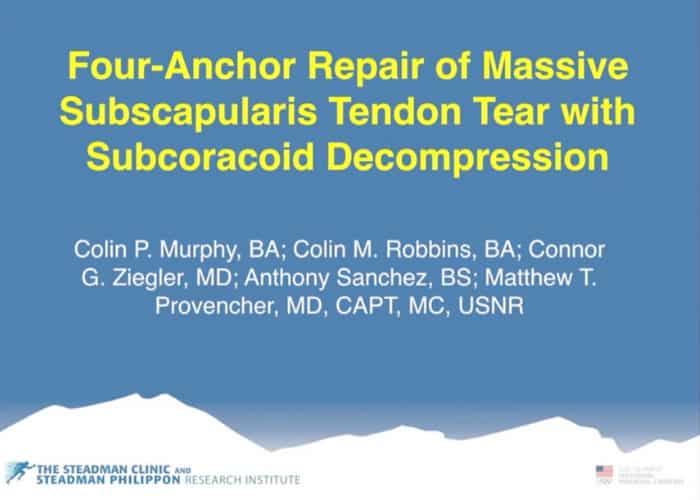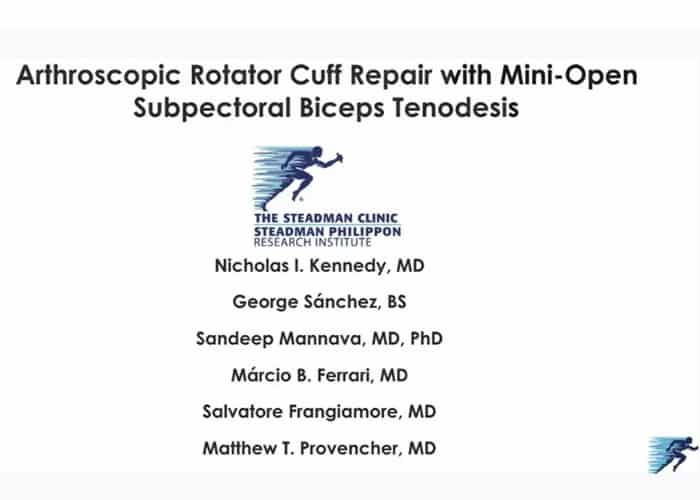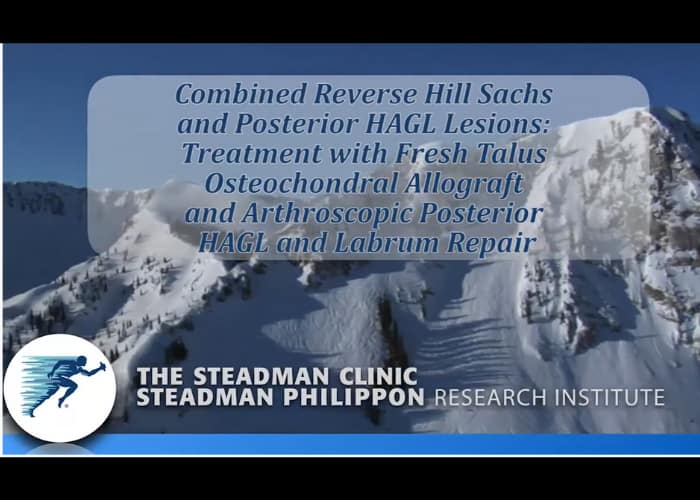Tears involving the muscles of the rotator cuff demonstrate significant variation in severity. Depending on the type of tear, location, muscle quality, and extent of retraction, management of the rotator cuff tear can also differ considerably from patient to patient. In cases where surgical management is indicated, the surgeon has many options, including debridement, arthroscopic [...]
Arthroscopic Rotator Cuff Repair with Mini-Open Subpectoral Biceps Tenodesis
A rotator cuff tear can often be treated without surgery, especially if chronic. However, the tear needs to be watched closely so that it does not progress and to diminish the chances of fatty atrophy of the muscles of the cuff. However, tears that are acute, larger, and those that are even chronic, but have [...]
Treatment of a Reverse Hill Sachs Lesion and Posterior HAGL Lesion Labrum Repair
Chronic posterior glenohumeral joint instability can be a challenging clinical entity for patients and surgeons alike. In the setting of a posterior dislocation, a large anterior humeral impaction injury (reverse Hill-Sachs [HS]) may occur, leading to engagement of the humerus with the posterior glenoid bone, especially during internal rotation of the joint. This is made [...]
Open Repair of an Anterior Humeral Avulsion of the Glenohumeral Ligament (HAGL)
A Humeral Avulsion of the Glenohumeral Ligament, or HAGL lesion, is an uncommon yet disabling shoulder injury, which leads to complaints of pain and overall inability to properly use the shoulder from patients. While a posterior HAGL lesion is repaired arthroscopically, an anterior HAGL lesion is treated through an open approach. Often, these can be [...]
Arthroscopic Labral Repair in the Setting of Recurrent Posterior Shoulder Instability
Posterior shoulder instability is becoming more commonly recognized and is a problem with the posterior labrum (usually a tear) that can cause pain, dysfunction, and limitation of shoulder activity. Nonoperative management is the mainstay of treatment, including scapular stabilizing exercises, however, in cases that are resistant to a good therapy program, and if pain with [...]
Anatomic Humeral Head Reconstruction with Fresh Osteochondral Talus Allograft for Posterior Glenohumeral Instability with Reverse Hill-Sachs Lesion
The treatment of recurrent glenohumeral instability, especially with a concomitant bony lesion, remains challenging. Moreover, the presence of an engaging reverse Hill-Sachs in combination with posterior instability will result in the need for a more aggressive treatment option. Large bony defects of the humeral head have traditionally been treated with a fresh humeral head allograft. [...]
Treatment of Glenoid Bone loss: Use of Cutting Instrument for Fresh Osteochondral Distal Tibia Allograft Preparation
Glenoid bone loss presents a major risk for glenohumeral instability, and while most surgeons consider the Latarjet procedure as the gold standard, failures can occur with this technique. The search for alternative grafts to address glenoid bone loss is a major topic of ongoing research in the field. Of these techniques, the distal tibia allograft [...]
Treatment of Bipolar Bone Loss: Use of Fresh Osteochondral Distal Tibia and Humeral Head Allografts
With increasing shoulder instability events, the likelihood of a bony lesion of the glenoid and/or humeral head rises. Although bone loss of either the glenoid or humeral head may result in recurrent instability, bone injuries on both sides of the joint – or bipolar lesions have been shown, in particular, to result in a negative [...]
Latarjet Technique for Treatment of Anterior Shoulder Instability with Glenoid Bone Loss
Anterior glenohumeral instability is a common clinical entity, particularly among young athletic patient populations. Coracoid transfer, particularly the Latarjet procedure, has become the treatment of choice for recurrent anterior glenohumeral instability in the setting of osseous deficiencies greater than 15% to 30% of the glenoid surface area and may also be considered for the primary [...]
Revision Acromioclavicular-Coracoclavicular (AC-CC) Reconstruction: Use of Dog Bone and Two Allografts to Fix the CC Ligaments and AC joint Capsule
Injuries to the acromioclavicular (AC) joint are common, particularly in the young and active population. Type I and II injuries are typically treated nonoperatively, while type IV–VI injuries are most often treated surgically. A variety of surgical techniques have been described, including anatomic and non-anatomic reconstruction. However, up to 80% go on to lose radiographic [...]


